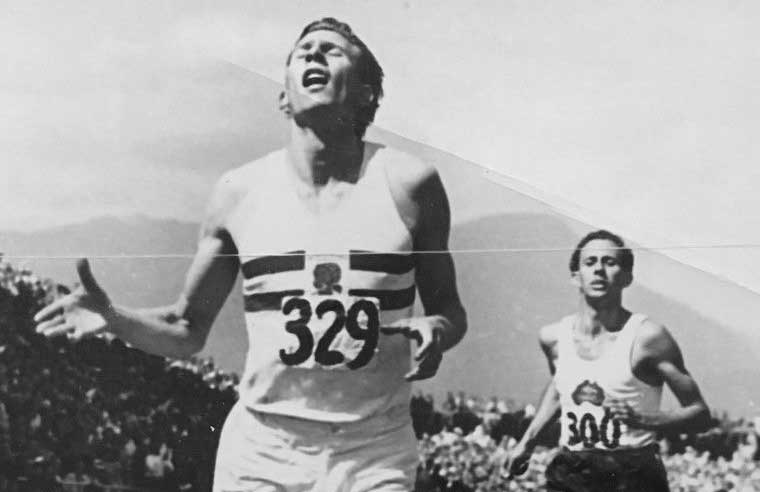The First Sub-Four-Minute Mile
Richard Cavendish describes the race in which Roger Bannister ran the first sub-four-minute mile, on May 6th, 1954.

Breaking four minutes for the mile had been an obsession among middle-distance runners for years. A time of just under four and a half minutes had been recorded far back in 1861 by an Irishman named Heaviside. In 1923 the famous Finnish athlete Paavo Nurmi ran the distance in 4 minutes 10.4 seconds. Slowly the figure came inching down. The New Zealander Jack Lovelock did 4.07.6 in 1933, the Englishman Sydney Wooderson 4.06.4 in 1937, the Swede Arne Andersson 4.01.6 in 1944 and in 1945 another Swede, Gunder Haegg, lowered the record to 4.01.3, only a fraction off the target. At Oxford that windy May afternoon in 1954 a far bigger crowd than would normally have been seen at the university's ramshackle Iffley Road stadium gathered there because word had gone round lecture halls, coffee shops, pubs and places where they sang that something exciting was up. An attempt was to be made on the four-minute barrier as part of a match between the university and a team from the Amateur Athletic Association. As it proved, the mile event was no contest in terms of the match - the university runners were totally outclassed - but it could hardly have rated higher in terms of excitement.
The three principal runners involved for the AAA were Roger Bannister, Chris Chataway and Chris Brasher, and the attempt had been carefully planned between them, though down to the last moment they had misgivings about the weather conditions. The bespectacled Brasher set a pace for the first two laps which Bannister at the time feared was too slow (as he revealed in his book, The First Four Minutes), but it proved to be exactly right. The halfway mark was reached in 1 minute 58 seconds. The diminutive Chataway took the lead halfway through the third lap, with the far taller Bannister looming leanly behind him. On they went until the far straight of the last lap, when Bannister lengthened his stride, passed Chataway at speed and thundered majestically round the final bend. Head back, arms splaying out, he broke the tape, where an official with a nonchalant pipe in his mouth was concentrating on a stopwatch. Chataway came gamely in not far behind in second place and Brasher finished fourth.
There was a long pause while everyone waited in pent-up excitement until at last the race announcer solemnly gave out the result, saying who had won, who had come second and so on. Then he took a breath and said, 'Time...' and waited evilly to notch the tension even higher before going on to announce 'Three minutes...' The rest was lost in a storm of cheering, but the winning time turned out to have been 3.59.4. It was less than a second under the mark, but the job was done and no one who saw it done that day is ever likely to forget it.
Bannister's time was bettered within only a few weeks by the Australian runner John Landy, who turned in 3.57.9 in a race at Turku in Finland on June 21st. This set the stage for the 'miracle mile' at the Empire Games in Vancouver a few weeks later still, on August 7th, which pitted the two of them against each other. Bannister won after an epic race in which Landy led almost all the way, with Bannister overhauling him at the end to win. They both broke four minutes, Bannister coming home in 3.58.8 to Landy's 3.59.6. Bannister retired from athletics later in the year to concentrate on his career in medicine. He was knighted in 1975.




